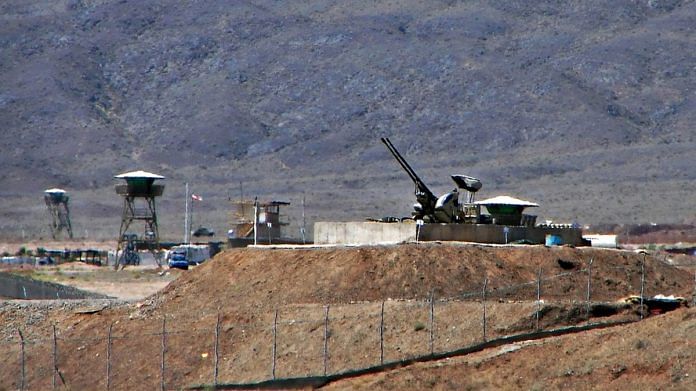New Delhi: Iran built Fordow, its uranium enrichment plant, deep inside a mountain to withstand strikes. Nearly half-a kilometre under the ground and guarded by anti-aircraft batteries, it was believed to be impenetrable except by American ‘bunker buster bombs’. And that’s what happened Sunday—six American B-2 bombers dropped 30,000-pound ‘bunker buster bombs’ on Fordow.
But so far, radiation levels have remained normal around the facility, according to the global nuclear watchdog International Atomic Energy Agency (IAEA). Iran’s other nuclear facilities in Natanz and Isfahan have also been hit.
“Following attacks on three nuclear sites in Iran, including Fordow, the IAEA can confirm that no increase in off-site radiation levels has been reported as of this time. IAEA will provide further assessments on the situation in Iran as more information becomes available,” said the IAEA in its latest statement.
ThePrint explains what’s inside the Fordow nuclear facility, which made it the epicentre of Iran’s nuclear weapons programme, and also the target of Israel and the US’s strikes.
Also Read: UN secretary-general says US strikes on Iran ‘threat’ to international peace, security
Fordow: the ‘crown jewel’
Iran’s underground nuclear facility, close to the holy city of Qom, has been its most closely-guarded secret. Iran formally disclosed its existence to IAEA only in 2009, after US intelligence agencies had already learnt of its existence. It is reported to hold thousands of advanced centrifuges required to enrich uranium. Its main halls are estimated to be around 262 to 295 feet below the ground, making it safe from conventional weapons, including aerial bombs.
Although little is known about Iran’s facility in Fordow due to the secrecy surrounding its construction and operation, satellite images suggest that work to develop the site likely began in the 2000s. According to IAEA, there are images that suggest construction of the facility likely began in 2002. Some publicly available satellite images from around this time show the existence of two square structures near the tunnel entrances of the facility’s current location.
The facility has been designed to enrich uranium, which, once it reaches weapons-grade, can be used to develop nuclear weapons.
In 2009, when the existence of the facility was made public, then US president Barack Obama said the size and the configuration of this nuclear facility were inconsistent with a peaceful programme, as claimed by Iran. When Fordow was unveiled to the world, it already had a full-fledged support structure on the outside, and the work for what is believed to be a ventilation shaft for the underground facility was ongoing.
In more recent satellite images, this shaft is not visible. IAEA reports have suggested that this shaft could have been camouflaged to protect it from being easily spotted.
This facility alone has nearly 3,000 centrifuge machines, which spin uranium at high speeds to eliminate uranium-238 (U-238) from uranium-235 (U-235).
In a letter to the IAEA, Iran said the reason Fordow was built as a “hidden, underground facility” was to prevent it from aerial strikes and bombings.
More information about Fordow came to light in 2018, after Israeli intelligence services got hold of more than 55,000 documents linked to Iran’s nuclear programme. These documents had detailed blueprints of Fordow and its future objectives, including the enrichment of weapons-grade uranium and the development of nuclear weapons.
According to IAEA, Iran has already enriched uranium to up to 60 percent purity, and would just require weeks to reach 90 percent enrichment levels—considered weapons grade.
A US-based research and advocacy group, the Institute for Science and International Security believes Iran could convert its current stockpile of 60 percent enriched uranium at the Fordow Fuel Enrichment Plant into 233 kilograms of weapons-grade Uranium in just about three weeks. “Around 233 kilograms of WGU would be enough to produce nine nuclear weapons, given that 25 kilograms of WGU is required to produce one nuclear weapon,” the institute’s latest assessment read.
The activities in Fordow have remained a cause of concern for other countries, including the IAEA. “The significantly increased production and accumulation of highly enriched uranium by Iran, the only non-nuclear-weapon state to produce such nuclear material, is of serious concern,” the IAEA’s report in May read.
Natanz and Isfahan
Iran has four primary facilities where its nuclear programme is focused.
Along with the Fordow Fuel Enrichment Plant, its nuclear programme is also being shaped at the Fuel Enrichment Plant and the Pilot Fuel Enrichment Plant in Natanz, and the Uranium Conversion Facility in Isfahan.
Natanz has Iran’s largest nuclear facility, which deploys nearly 20,000 centrifuges—machines that spin at high speeds to enrich uranium. The facility, located roughly 240 km from the capital city, Tehran, has about six above ground buildings and another three underground facilities.
According to a US-based think tank, the Nuclear Threat Initiative, in 2022, as many as 4,000 advanced centrifuges were installed here in just about two months—greatly increasing Tehran’s capacity to churn uranium.
Natanz is where all the action happens, but Isfahan is where all the science is centred.
The Isfahan Nuclear Technology Centre is the country’s largest nuclear research centre. Built with Chinese assistance and opened in 1984, according to the Nuclear Threat Initiative, the facility has around 3,000-4,000 scientists working there to chalk out long-term plans for Iran’s nuclear programme.
This centre has a uranium enrichment plant, small research reactors, a fuel production plant and a zirconium cladding plant. Zirconium and its alloys improve fuel performance by assisting higher fuel burnups and lower failure rates.
(Edited by Amrtansh Arora)
Also Read: Iran’s brutal regime is facing a reckoning. Consequences of US attack will go beyond Tehran






